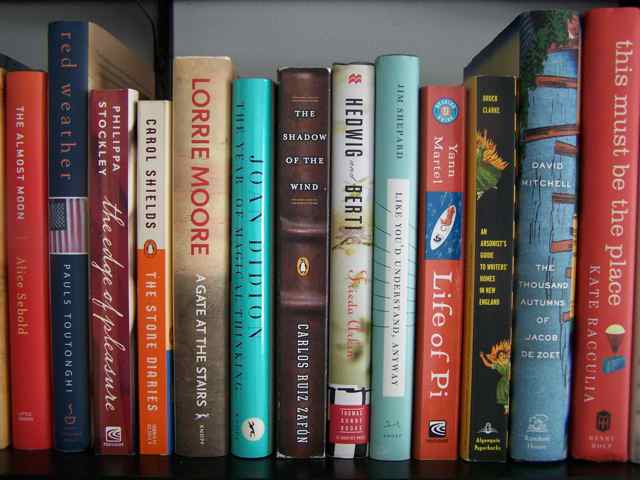 Cutting for Stone by Abraham Verghese is much longer, but much, much better, than The Kite Runner. Cutting for Stone and The Kite Runner were both books I read only because so many people asked me if I had. I’m abysmally ignorant about politics and world history, and always feel that my ignorance about an unfamiliar setting like Ethiopia or Afghanistan will make it harder to get immersed in the story. Also, the title Cutting for Stone made me think of stonemasons (BO-O-O-RING) when it really refers to surgery.
Cutting for Stone by Abraham Verghese is much longer, but much, much better, than The Kite Runner. Cutting for Stone and The Kite Runner were both books I read only because so many people asked me if I had. I’m abysmally ignorant about politics and world history, and always feel that my ignorance about an unfamiliar setting like Ethiopia or Afghanistan will make it harder to get immersed in the story. Also, the title Cutting for Stone made me think of stonemasons (BO-O-O-RING) when it really refers to surgery.
Cutting for Stone is a big novel that’s a good choice for a book club read, because it is packed with discussable subjects, including the exotic setting of Addis Ababa in Ethiopia (pronounced by natives as “Ethyo-pya”, not “Eee-theee-op-eee-ya”); political upheavals; terrorism; hospitals as institutions; doctors as professionals and as people; emigration and foreignness; how the culture of medicine compares from one country to another or one hospital to another; twin-ness and family; the many mystical moments in the story, and the meanings the author has layered into the narrative.
Cutting for Stone is essentially the story of Marion Stone, who becomes estranged from his twin brother, Shiva, and throws himself early into the study of medicine, planning to become a surgeon, as they go from conjoined babies who had to be surgically separated at birth and who slept together head to head as boys, into identical-looking teenagers with utterly distinct talents, personalities, and ease of being in the world. Marion and Shiva (like the author himself) are raised by Indian doctors in Ethiopia. Their adoptive parents, Hema and Ghosh, work and live at the run-down Missing Hospital. The title Cutting for Stone comes from the Hippocratic Oath, but also refers to Thomas Stone, the hospital’s third doctor for many years – the surgeon-father whose absence looms large over Marion’s childhood and whose presence in Addis Ababa is known only by the sons he left behind and the medical knowledge he passed on to Marion’s adoptive parents who then passed it on Marion and Shiva.
This would have been a very different book if brilliant, graceful, spiritual Shiva had been the one narrating – piecing together the pasts of their absent parents and adoptive parents, guessing others’ thoughts and parsing their actions, while making his way through life – but Shiva would not have felt the need to write the story. Where Marion plans and works ever harder at his studies, Shiva succeeds effortlessly at everything but doesn’t seem to notice. Marion says of himself, as an adult surgeon, in the book’s prologue:
“…I am not known for speed, or daring, or technical genius. Call me steady, call me plodding; say I adopt the style and technique that suits the patient and the particular situation and I’ll consider that high praise….Knowing when not to operate, knowing when I am in over my head, knowing when to call for a surgeon of my father’s caliber–that kind of talent, that kind of “brilliance,” goes unheralded.”
This would have been a very different book if brilliant, graceful, spiritual Shiva had been the one narrating – piecing together the pasts of their absent parents and adoptive parents, guessing others’ thoughts and parsing their actions, while making his way through life – but Shiva would not have felt the need to write the story. While Marion plans and works ever harder at his studies, Shiva succeeds effortlessly at everything but doesn’t seem to notice. Throughout his adolescence and long years of medical training, Marion is uncomfortable in his own skin and prickly by nature. Although he struggles to find a mystical communion with his mother through her few belongings, his nature leads him to observe and describe his life clinically. As a reader, I also felt like a detached observer and wasn’t gripped by the novel until close to the end. Only a few of the other characters come fully to life. This may have been the author’s intention, but I found myself wishing for more fully-drawn characters and that Marion would get a life. Also, be forewarned, if you tend towards queasiness, the descriptions of surgeries are long and very detailed.
Cutting for Stone is a good novel, well worth reading, that will appeal to a variety of people and would be great for a book discussion group.
This is the first book completed for my TBR Pile Challenge. I was given a friend’s copy of the book to get me to read it, and now I can tell her I finally did!
